The Penn State Extension Master Gardeners of Cumberland County conducted trials of annual plants donated and purchased from area garden centers in 2023 to increase public awareness of exceptional plants that perform well in our area.

2023 Trial Garden, Carlisle, PA
Plant Sources
Each year one of the six beds at the Trial and Idea Garden is planted with new and exciting plants to test their performance in central Pennsylvania gardens. New cultivars and recently released cultivars for Northeast gardens are sought. In late winter, committee members make suggestions for plants for the Trial Garden. The ideas come from news articles, catalogs, and growers' reports. Close to the average last frost date in our area, our wish list is sent to Ashcombe Farm and Greenhouse who generously donates many of the plants for the Trial Garden. Ashcombe always provides an exciting array of cultivars. Additional plants from local garden centers supplement the donated plants.
Twenty to twenty-five different cultivars are planted in the Trial Garden each year generally in groups of three to five. The taller cultivars are placed in the center of the garden with shorter plants placed along the perimeters. In 2023, twenty-four cultivars were planted.
The Sign Garden and the Pollinator Garden also receive some colorful annuals to complement the perennials in those beds. The annuals in the Sign Garden are provided by Allaire Health Services, the organization that owns the property where the Trial and Idea Garden is located. Allaire also supplies mulch for all the garden beds.
Methods
The Trial and Idea Garden is tended on a weekly basis by our committee members. Early in the season, special attention is directed at watering our newly planted annuals. Regular and necessary garden maintenance is performed throughout the growing season with additional spring and fall work days. No fertilizer other than compost from our three-bin composting system is used.
The plants in the Trial Garden are evaluated every other week by members of the committee. In 2023 the rating system was modified to be in concert with that used at the Penn State Southeast Agricultural Research and Extension Center (SEAREC) in Lancaster County. Plants are evaluated on a scale of 1 (low) to 5 (high) in four categories - uniformity, foliage, flower, and growth - based on expected behavior for that cultivar. Insect damage, disease, and weather-related stresses are considered in the evaluation process but animal damage is not. In 2023 evaluations began in early June, three weeks after planting. Evaluations ended in late August for cultivars that showed significant decline and continued through the end of September for those cultivars that were still performing well. Three cultivars were particularly attractive to the areas' wildlife so the evaluation of their performance was curtailed earlier in the season. Flower count and size measurements were taken from the best performing plant in each group at the first evaluation in August.
The score for each group is translated into a percentage to allow an even comparison of performance since some plants are not evaluated in all categories. For example, this year, only one Popcorn Cassia (Senna didymobotrya) was planted and therefore not evaluated in the uniformity category. The score as a percentage is listed after the cultivar name along with the expected height range and width where available. The 'tt' designates a plant that is a 'true trial' - a cultivar that is not wholly available in the retail market.
In 2023 the gardens were subjected to extreme fluctuations in temperatures early in the planting season, followed by high temperatures and limited rainfall. Several days after planting the annuals, frost warnings rallied our team to protect the plants. Near drought conditions continued from 2022 through 2023 in central PA presenting challenges for gardeners and wildlife alike. Some plants in the Trial Garden did not fare well and others flourished. Reflected in the rating, all the plants grew slowly the first month in the ground then quickly increased in size as some rain began to fall and the temperature, especially overnight, moderated.
Results
Results are organized into three groups based on the number of weeks the cultivar was evaluated. Enjoy the following tour of the 2023 plant trials at the Trial and Idea Garden.
The first group of three cultivars have a score relative to their individual short-lived stand in the garden. Some were caged for short periods to protect them from the local wildlife. Comparative evaluation with the other plants in the Trial Garden would be inappropriate. This group did not participate in the flower count or size measurements.
Impatiens X hybrida SunPatiens® Vigorous Sweetheart (18-34 in. X 24-36 in.)
All three plants of Vigorous Sweetheart were eaten to the ground shortly after planting. By the second evaluation in mid-June one plant showed enough new growth to earn a 4.5 for the flower. At the next evaluation, one plant displayed foliage with a nice variation in color. The other two plants remained stubs barely above the ground. From mid to late July, two plants were making a great comeback and were evaluated in all four categories earning an 86% over two evaluations - approximately four weeks. During this brief reprieve from animal pressure, one plant was full of opened and unopened flowers and the foliage remained green and lush during many 90+ degree days although the variation in the foliage color faded. This Impatiens shows promise for a good performance in a full sun garden over the summer. The fate of Vigorous Sweetheart in our garden was similar to our experience with Impatiens hybrida 'Solarscape Salmon' in 2022.
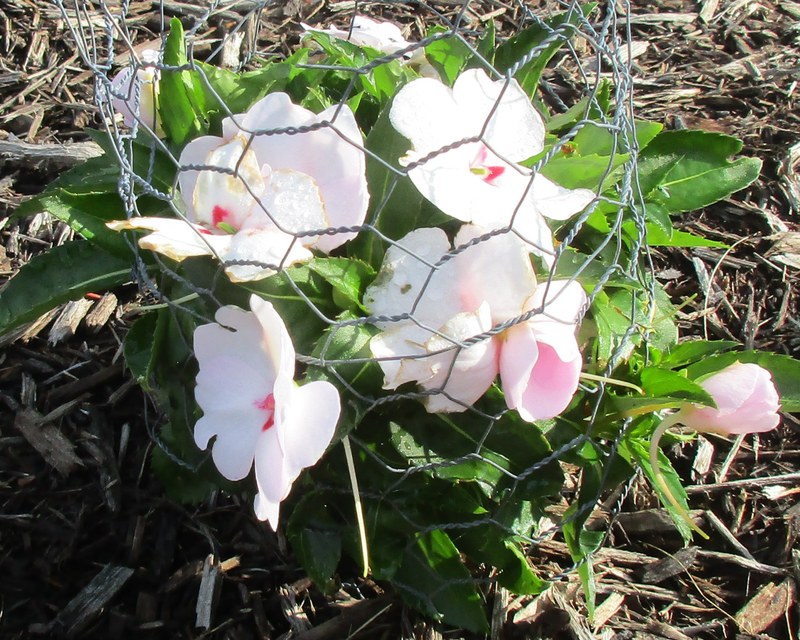
Cuphea ignea 'Sugarbells' (10-12 in. X 14-20 in.; tt)
'Sugarbells' also did not fare well in the Trial Garden. The three plants survived for three weeks in the garden - from planting through the first evaluation in early June achieving a rating of 83%. The foliage on this Cuphea was not particularly attractive. The flower is very dainty and does not make a contribution to the overall look of the plant. By the second evaluation in the middle of June, two of the plants suffered significant animal damage so only one plant was evaluated. Thereafter the plants showed no sign of recovery and quickly there was a bare spot in the garden. This year's Cuphea followed suit with the three different Cuphea cultivars in the 2022 garden - a favorite snack of the wildlife.
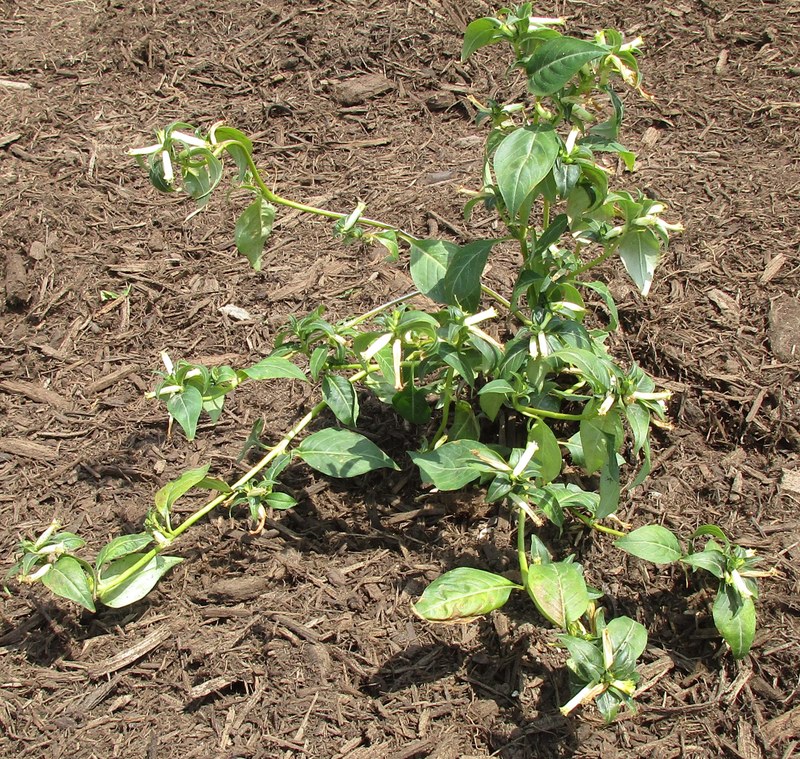
Abutilon hybrid 'Lucky Lantern Yellow' Flowering Maple (12 in. X 12 in.)
The three Flowering Maple plants were about a foot high on planting day but reduced to stubby twigs shortly thereafter. A tropical plant, they struggled to recover during the cool late May and early June temperatures mixed with continual animal pressure. Caged in early July and combined with more tropical weather, they filled the small cages by the end of July and participated in two evaluations in July. This pattern of growth followed by nibbling continued through the growing season until the size of neighboring plants provided some protection. Overall, one or more of the three Flowering Maple plants participated in four evaluations with a final rating of 84% given that animal damage is not considered in the evaluation process. A good rating but rarely a good presentation in our garden. Almost always viewed through caging with some stubby stems.
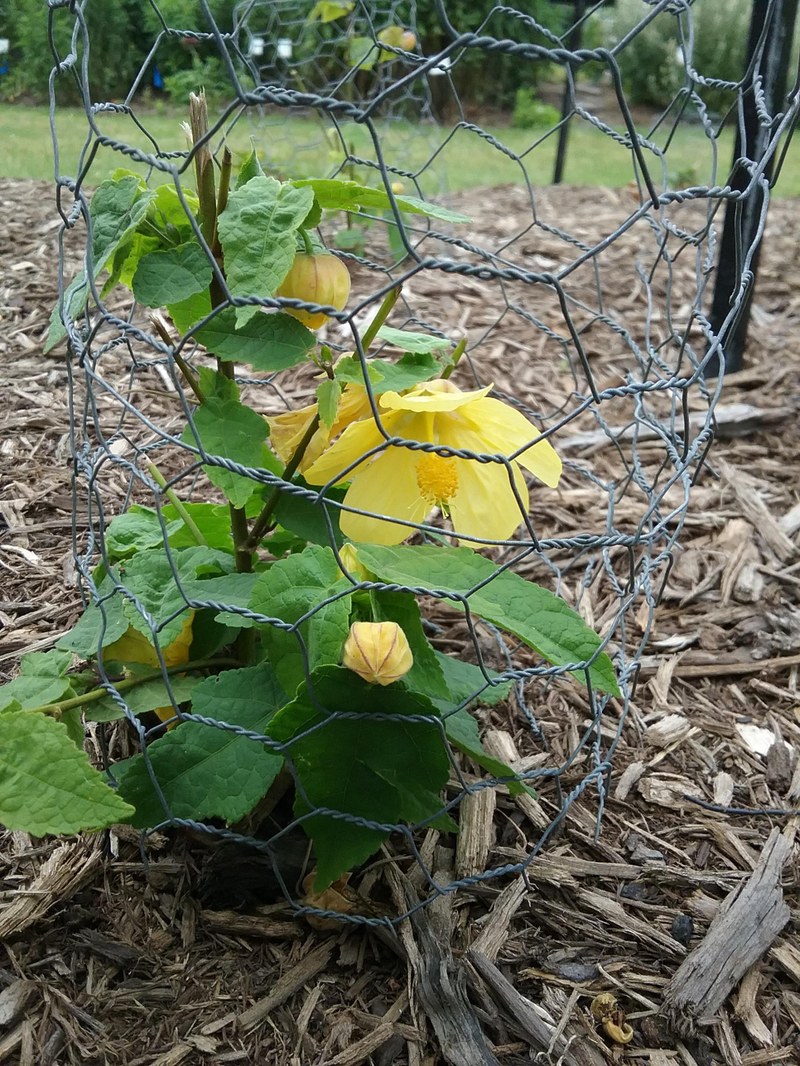
Eight of the cultivars in the 2023 Trial Garden participated in seven of the nine evaluations beginning in early June through the end of August. At the mid-September evaluation, this group showed significant decline which would have dramatically reduced their final rating. Since traditionally evaluation of summer annuals is discontinued at the end of August, the meteorological end of summer, evaluation of this group of summer annuals was discontinued.
Calibrachoa hybrida Bumble Bee™ Orange Calibrachoa (61%; 6-12 in. X 12-24 in.; tt)
Truly a beautiful flower with a deep yellow throat surrounded by five purplish-orange petals rimmed with creamy pastel coloration. The petal colors begin as dark and vivid, softening as the flower ages. At least as many petals lean toward the purple end of the spectrum as do the orange end of the spectrum. This calibrachoa was a slow grower until the middle of the summer when it became strikingly beautiful. Its time as a beauty was short-lived. As the weather heated up, this calibrachoa faded fast earning a description as 'overall ugly' at the late July evaluation and had declined so significantly that there was no flower count or measurement in August. Very stunning for a short time in the garden.

Sedum 'Little Shimmer' (80%; 2-3 in. X 5-7 in.; tt)
An all-around dainty plant, this sedum displays tiny leaves with a beautiful variation of color and even tinier red to pink flowers. Close observation is needed not to mistake the tiny, tiny flowers as another variation in the leaf color. Deadheading is impossible due to the tiny flower size and the browning of the spent flowers significantly detracts from the appearance. Some new flowers formed in early August but from that time forward the plants were generally unattractive and past their prime. Some animal damage was evident in late August. Overall although this sedum is rated as hardy to zone 6, it seemed the plants could not withstand the late summer heat. One of these 2-inch high by 9-inch wide plants was estimated to have 400 very, very tiny flowers.
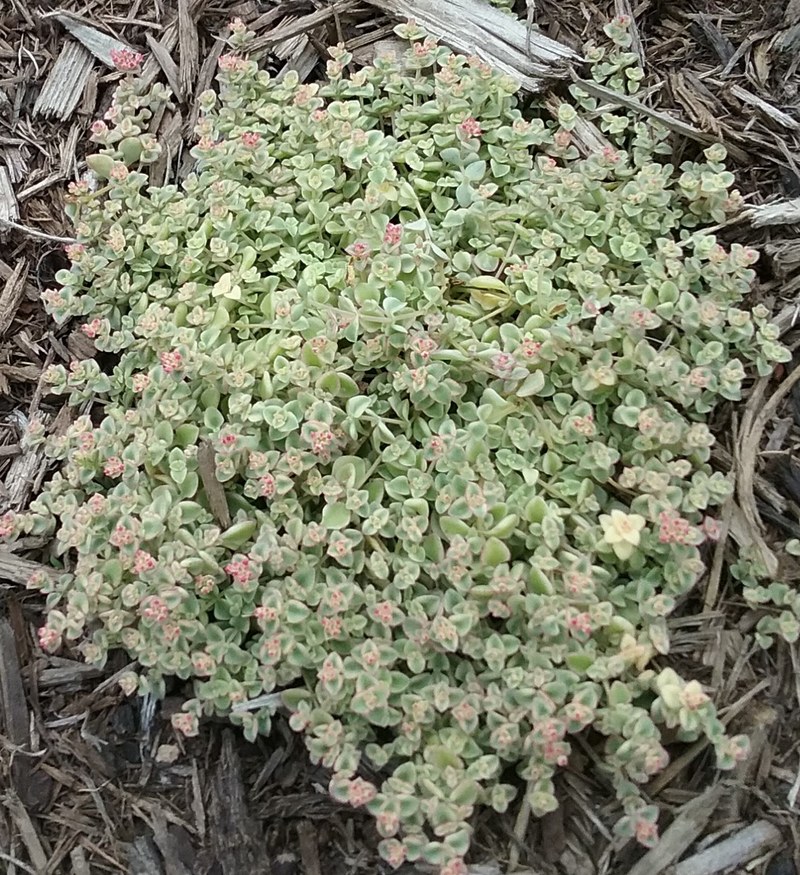
Argyranthemum intergeneric hybrid Grandaisy® Red Improved (91%; 18-24 in. X 18 in.)
Brilliant red flowers surrounded by fern-like foliage made a beautiful presentation. As the flowers aged, they faded to a muted red. Rather than detracting from the appearance, the combination of reds just enhanced the overall presentation. A prolific bloomer, the largest plant measured 26 inches high by 36 inches wide with just over 120 blooms. At the early August flower count, there were many new buds among the newly opened and fading flowers. However, by late August most blooms had faded, and the foliage was beginning to look yellow and spent. The plants received a major trimming to revitalize them but the decline continued. These plants were beautiful until the end of August and then just gave up.
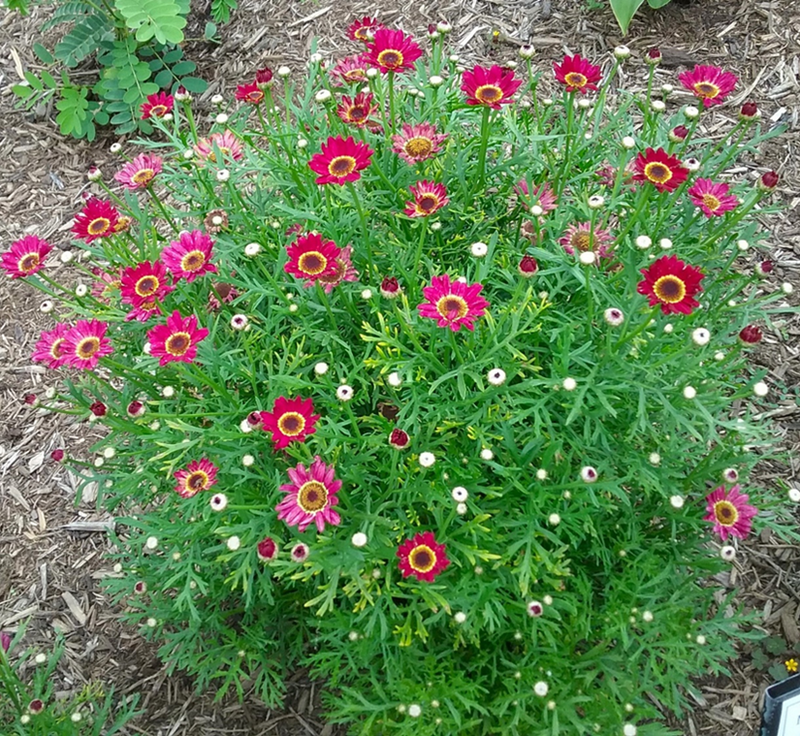
Dianthus chinensis Coronet™ White Purple Eye Dianthus (91%; 8-10 in. X 8-10 in.)
With the cool weather in late May and early June, Coronet™ White Purple Eye got off to a slow start. The plants were small when they arrived at the garden in a 4-pack with few flowers. They remained small as their predicted size indicated and slowly began to push out numerous lovely flowers, as named, white with a purple eye and the classic dianthus frilly edges. Also in classic dianthus style, they needed continual deadheading to keep producing flowers. The growth measured 4 inches by 7 inches, under the predicted, with 14 flowers on one plant.

Petunia hybrid Supertunia® Latte™ (93%; 6-12 in. X 12-24 in.)
One of the three Petunias was pulled out of the ground by a neighborhood pest shortly after planting. It recovered but remained smaller than the other two plants. Therefore, the ratings were based on the two plants. By the end of August, they were eaten to stubs - thus placed in this end-of-meteorological summer group. However, while our furry friends were enjoying other plants in the garden, this petunia produced a truly stunning display of flowers. Measuring 5 inches by 22 inches with 110 beautiful white flowers with a deep purple-chocolate throat bleeding up to the petal edges. A stunning flower, but like many petunias, appreciates frequent deadheading.

Gazania rigens Big Kiss™ Yellow Flame (94%; 8-10 in. X 8-10 in.)
Big Kiss™ Yellow Flame is another flower that had a tough start. Starting with rather small plants, they were pulled out of the ground in early June, replanted, and chewed down close to the ground. However, two plants made a big comeback, gracing the garden with striking yellow flowers with an orange blaze down the center of each petal, until the end of August when they once again became a meal for the local wildlife. The flowers close up in low light and then lift their heads to the sun. Gazania Big Kiss™ missed one evaluation in mid-June while recovering from animal damage but otherwise two of the plants made a good showing through the end of August. The healthiest plant measured 5 inches high and 14 inches wide with 14 amazing flowers on the flower count date. These have the potential to remain strong through early fall if protected from browsing.

Pennisetum glaucum 'Jade Princess' Ornamental Millet (97%; 24-30 in. X 18-24 in.)
'Jade Princess' was a real treat this year in the garden. Without a traditional flower, the foot-long bottle brush spikes are an unusual and pleasing addition to the annual garden. The rich brown, pollenless panicles that top 'Jade Princess' provide an impressive and pleasing contrast to the long, slender lime green leaves. A graceful beauty sways in light wind. This millet was a stunner from the time they were planted through the end of August. The panicles began to appear in early June. By the end of August, the leaves were turning yellow and flowers looked tired. The largest of the tree plants measured 30 inches high and 37 inches wide with 47 panicles. No takers to count the individual flowers.
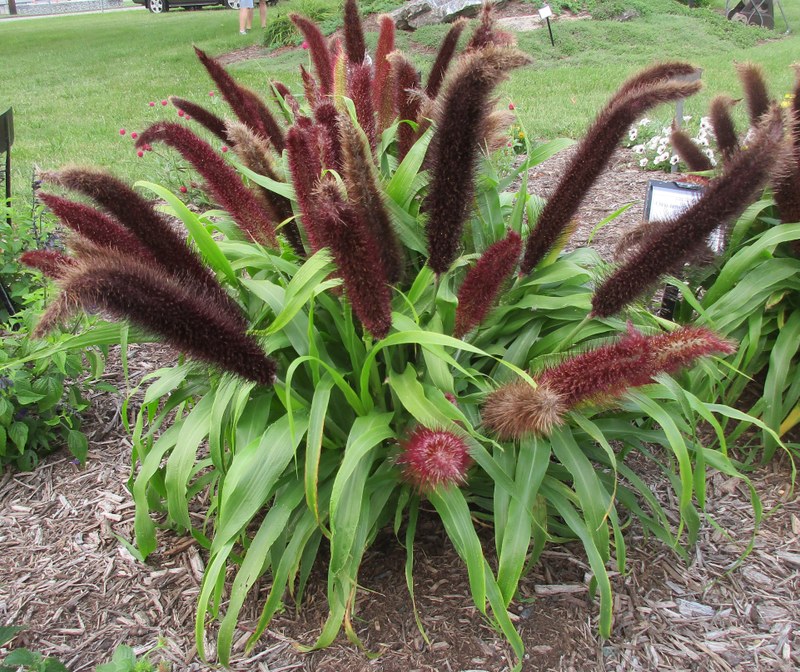
Argyranthemum frutescens Golden Butterfly® Marguerite Daisy (98%; 18-36 in. X 12-14 in.)
Golden Butterfly® created an exquisitely beautiful display in this year's Trial Garden. Just shy of a perfect score, losing a point at the first evaluation due to a slow start and a point at the end, most of the season the garden was indeed covered with Golden Butterflies from this cultivar. A profuse bloomer, Marguerite Daisy measured 29 inches tall and 20 inches wide with 208 blooms in early August. The flowers are held on delicate stems inches above the feathery foliage. Like the red Argyranthemum in the 2023 Trial Garden, in early September the new blooms were not numerous enough to compensate for the spent blooms.

The next group of 13 cultivars thrived through the hot and dry conditions of late summer 2023 and so participated in two more evaluation cycles through the end of September. Most were not attractive to the wildlife and suffered limited or no damage. These cultivars retained their aesthetic value and would not be those plants targeted for replacement for the fall. Fall clean-up in the Trial Garden took place on October 22 with many of these plants still flourishing.
Salvia x guaranitica Bodacious® Hummingbird Falls Salvia (84%; 12-24 in. X 18-36 in.)
Four of the five plants that were planted in the garden participated in the evaluation since one of the plants declined immediately. The flower count registered 66 dark lavender blooms with a deep purple-black calyx on one plant that measured 21 inches wide and 26 inches high. However, Hummingbird Falls never gave the appearance of a prolific bloomer. The vibrant green foliage was heavily textured. By the end of August, the number of blooms dwindled dramatically as did the appearance of the foliage, the uniformity, and the growth. It is worth noting that had the evaluation of Hummingbird Falls been curtailed at the end of August instead of September the rating would have been 92%.
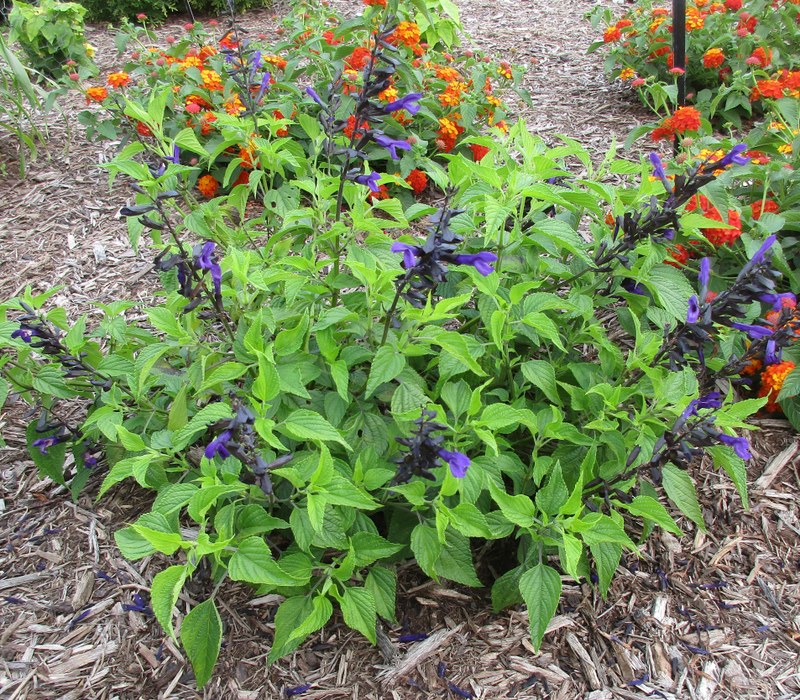
Catharanthus roseus Vinca Tattoo™ Black Cherry (90%; 10-14 in. X 6-8 in.)
The Black Cherry version in the Tattoo™ series was not as stunning as the three Tattoo™ cultivars in the 2022 Trial Garden. Nonetheless, it was a solid performer through the challenging weather of 2023. It was quite slow growing and did not grow to the expected size until mid to late July. The early August measurement was 11 inches tall and 14 inches high with 100 flowers on the largest of the plants. The four plants struggled to maintain a uniform size but the flower, like the others in the Tattoo™ series, is a pure knock-out. The color is dazzling with pink-red and purple-blue striations in each petal against the shiny deep green foliage. One plant in this group of four developed some yellowing of the foliage beginning in late August contributing to a lesser rating.
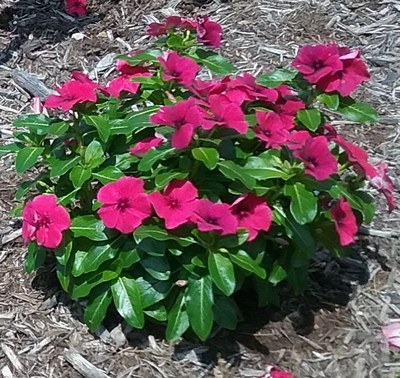
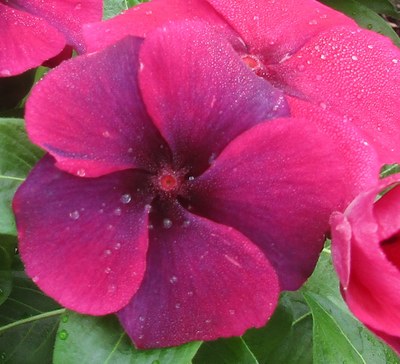
Catharanthus hybrid Vinca SOIREE® DOUBLE Pink (91%; 10-14 in. X 18-24 in.; tt)
This double-flower hybrid Vinca is a new look for an old favorite. The deep pink outer layer of petals lightens as they open to expose an inner layer of light pink to white spoon-shaped petals, all with a deep red splash where the petals meet the stem surrounded by the characteristic shiny green foliage of Vinca. The slow start in flowering and uneven growth rate of this Vinca accounts for the less-than-perfect score. It was worth the wait for the full elegant presentation from this cultivar. A total of 124 blooms were counted on a 15-inch high by 24-inch-wide plant in early August. Vinca SOIREE® DOUBLE Pink was still going strong in October showing none of the common yellowing of the foliage late in the season.
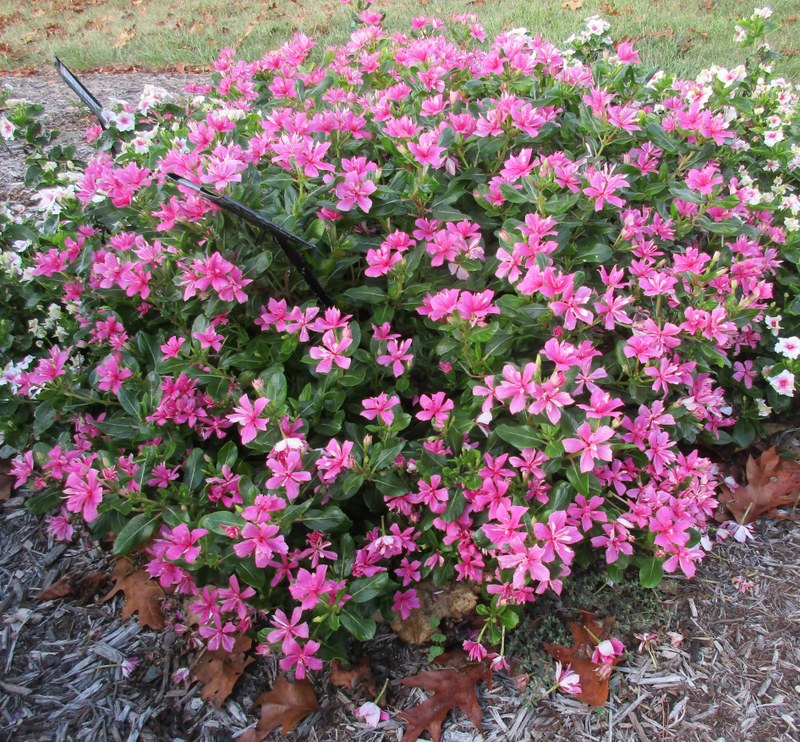
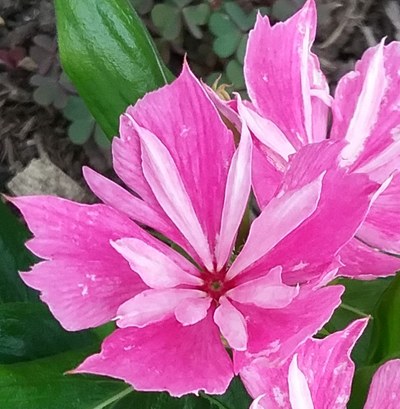
Lantana montevidensis Luscious® Grape Lantana (92%; 10-14 in. X 24-36 in.)
Luscious® Grape is a spreading lantana and like the other plants in the 2023 garden, got off to a slow start which affected its overall rating. It was relatively late in the summer growing season before this lantana came close to its predicted size and the fullness associated with lantana. As the summer heated up, Luscious® Grape rapidly increased in size reaching 8 inches high and 36 inches wide. It was difficult to discern the individual plants. The largest plant displayed 160 delightful purple flowers, more lavender in color than deep purple as 'grape' suggests, with white centers. The deeply textured foliage characteristic of lantana mostly retained its green color throughout the growing season. Some yellowing was present in the center of one plant in late July but returned to a healthy green by late August.
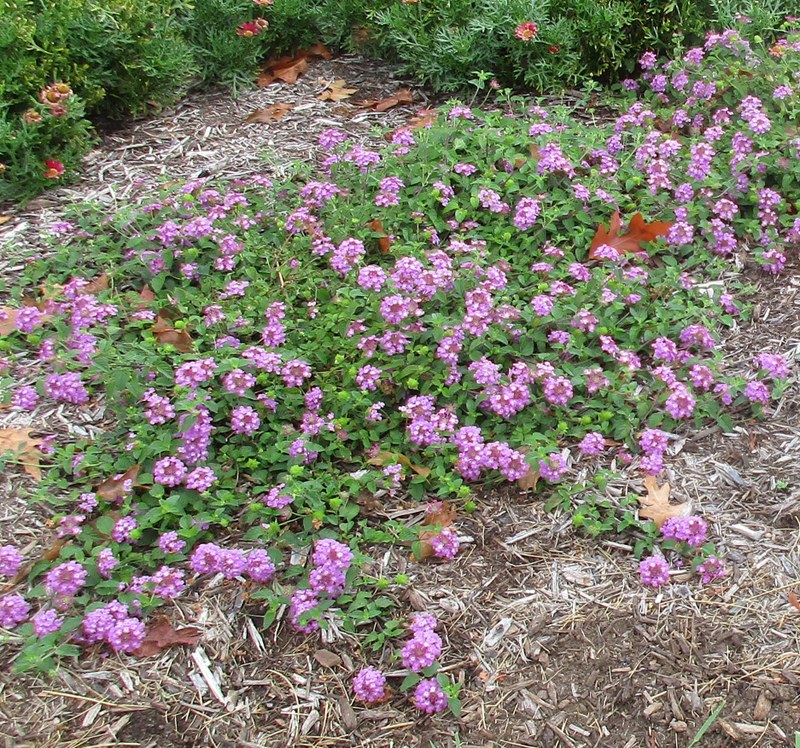
Celosia plumosa 'Flamma Orange' Celosia (93%; 8-10 in. X 6-7 in.)
A petite Celosia, Flamma Orange displays an intensely orange plume atop foliage that is a mixture of various shades of green and orange where the color combination is divergent from plant to plant. The variation in the foliage color across plants made a lovely presentation as a group. The four plants held a consistent size until late in the season when insect damage toppled the plume on one plant and another plant grew at a much greater rate than the others. The largest plant measured 14 inches high by 12 inches wide with 24 separate flower plumes. A good performance but the large number of flower plumes were much narrower and not as brightly colored as the earlier more singular plumes.
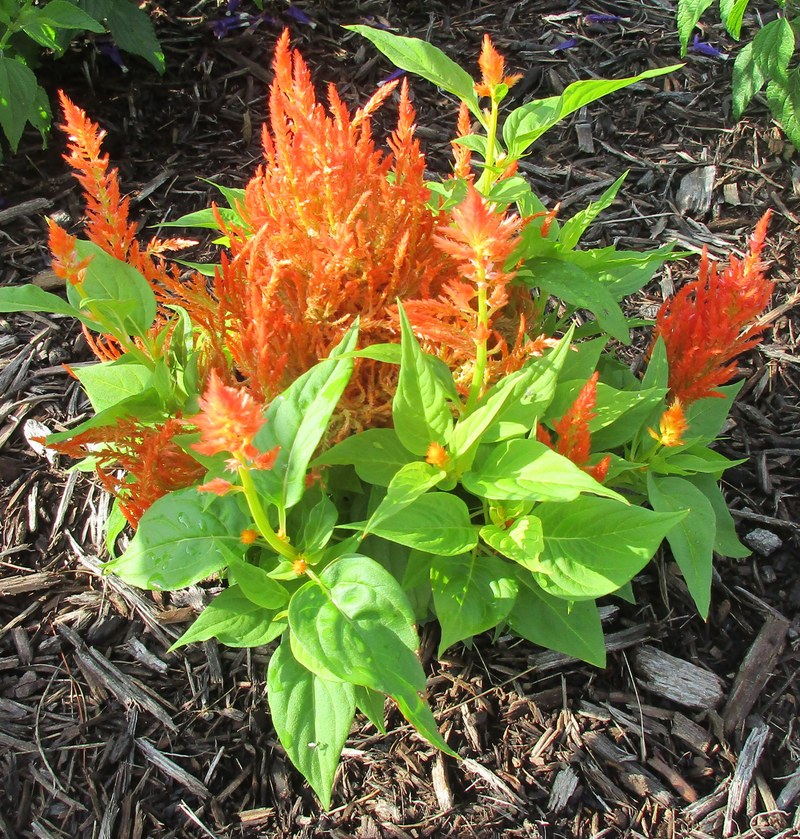
Catharanthus hybrid Vinca SOIREE® Flamenco Senorita Pink (94%; 8-12 in. X 15-20 in.; tt)
The SOIREE® series of Vinca is another example of a new take on an old favorite. SOIREE® introduces a bicolored flower with lightly fringed, ruffled petals. Flamenco Senorita Pink's bicolored flowers have a pink center that fades to white as it reaches the outer edges of the petal. It retained a tightly mounded habit throughout the summer heat and into the early fall. The three plants in our trial were somewhat uneven in size with some yellowing on the foliage when received. Before long they were growing and dazzling with perfect scores across the four categories from early July through the end of September. Reaching 13 inches high and 24 inches wide with 132 flowers Senorita Pink was a true star in the garden. Paired with Vinca SOIREE® DOUBLE Pink created a dramatic display.
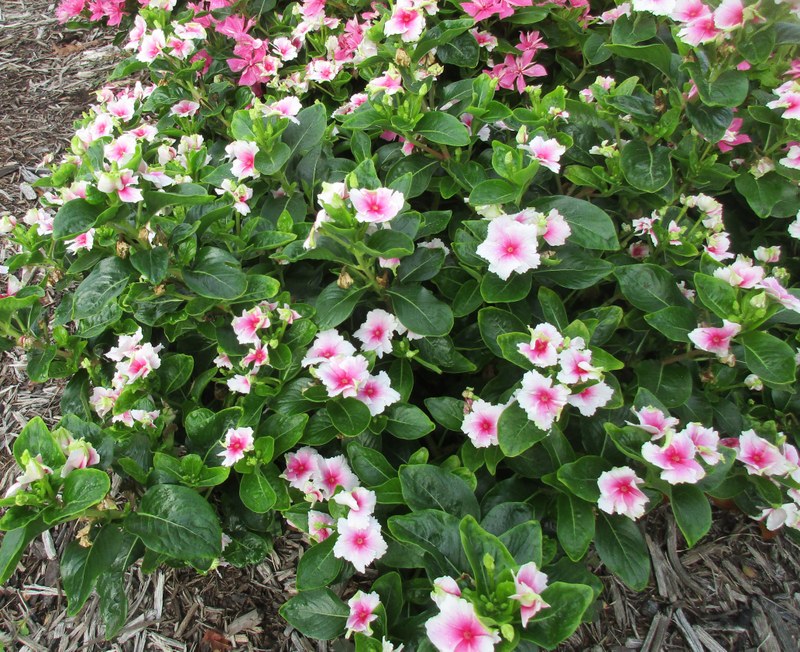
Senna didymobotrya Popcorn Cassia (94%; 8 ft. x 8 ft.)
This plant was chosen to provide some height as a centerpiece to the garden. Popcorn Cassia, so named because stroking the unopened flower buds leaves the scent of buttered popcorn on your hands, can reach up to eight feet in the proper conditions. As a single plant in the garden there was no rating for uniformity. Our plant reached 6 feet high with an almost 4 foot spread crowding its neighbors by late season. The growth was more lateral than upright early in the season with few blooms until late July. When the blooms started to come, they came with a flourish.
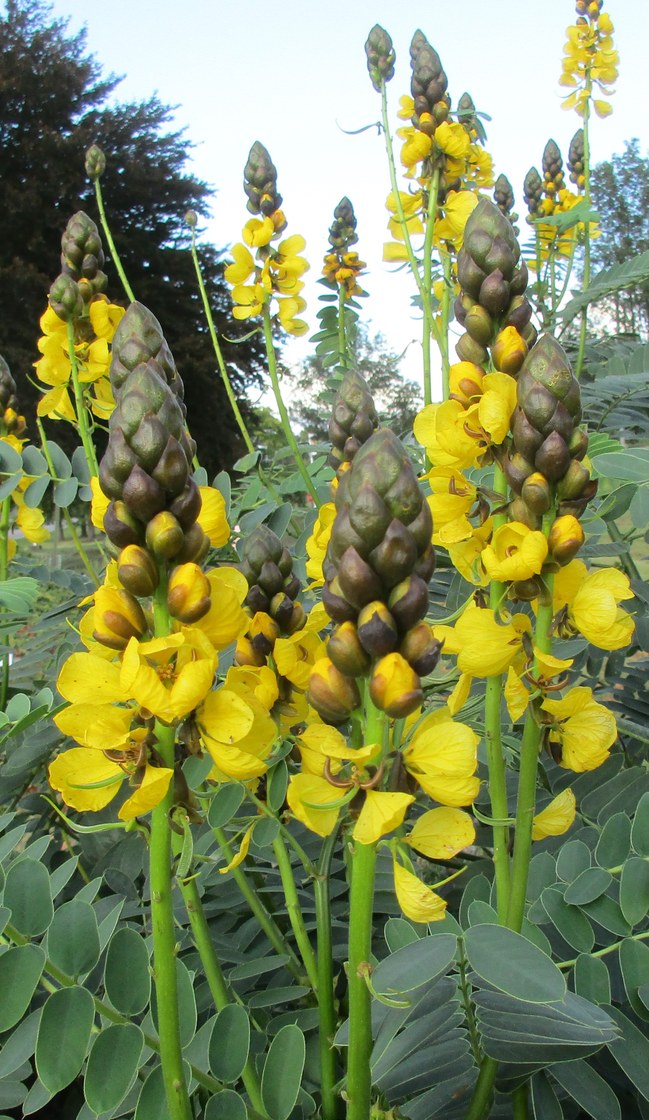
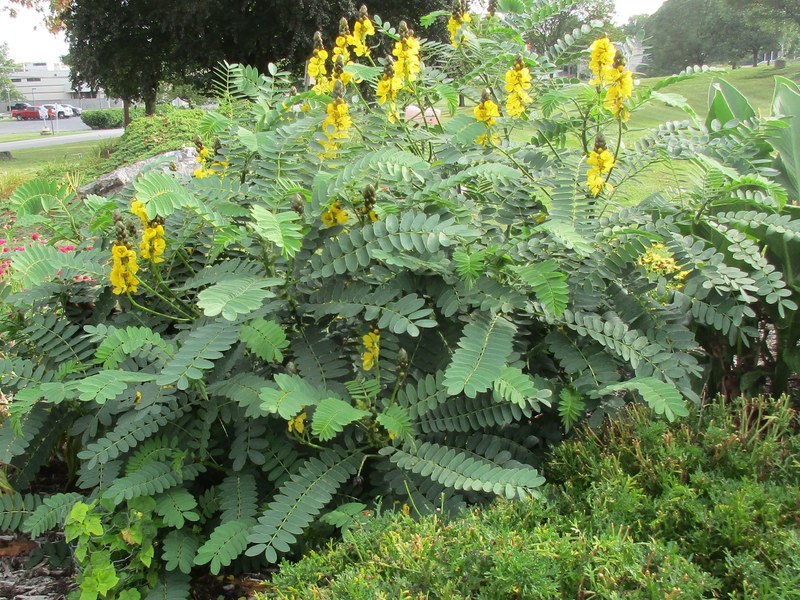
Canna X generalis Cannova® Red Golden Flame Canna Lily (95%; 30-48 in. X 14-20 in.)
Cannova® Red Golden Flame was not a true trial but 2023 is the first year it was widely available on the retail market. Sharing a spot in the center of the garden with Popcorn Cassia, the three pots of canna lilies furnished a bright splash among the tropical green foliage. Slightly lacking in uniformity and slow growth early in the season prevented the cannas from achieving a perfect score. The flowers and foliage were faultless throughout the season. Reaching three feet high and wide with up to six striking flower stalks with red petals rimmed with yellow, Red Golden Flame was appropriately named.
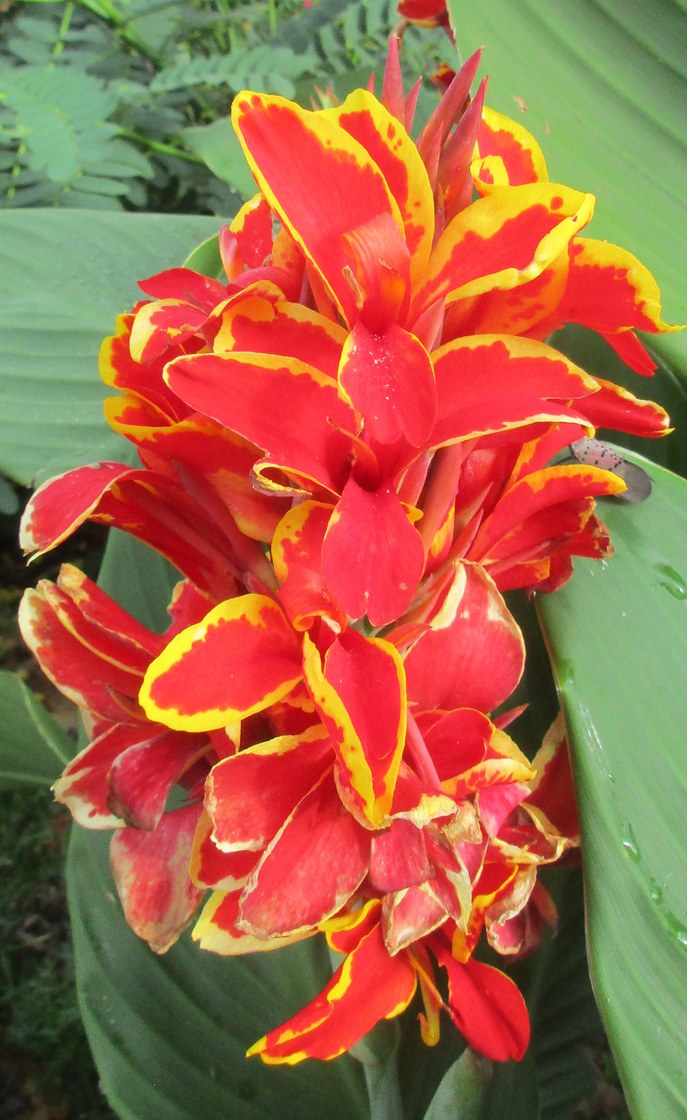
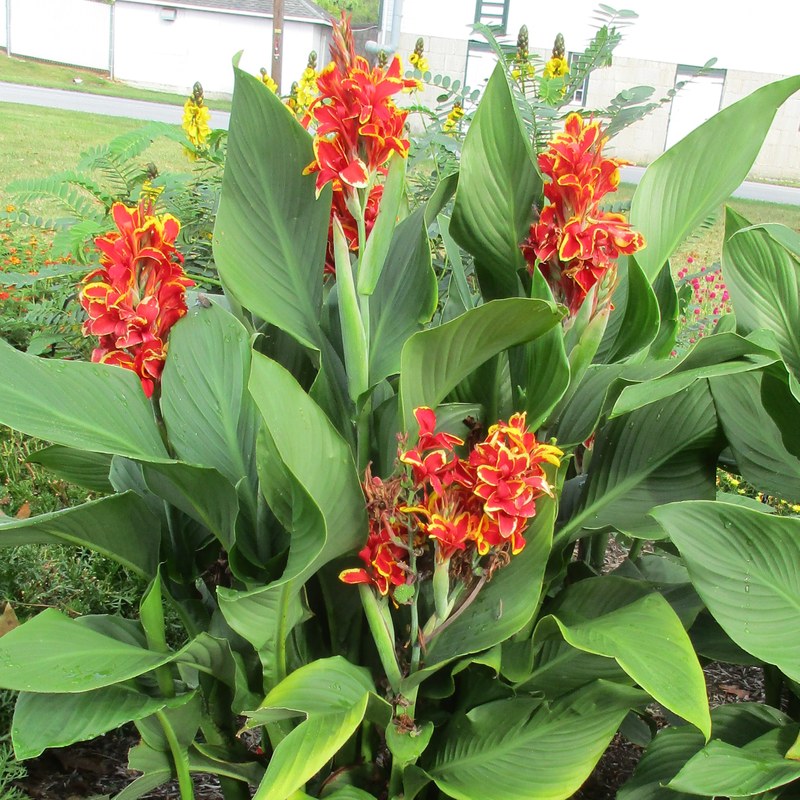
Gomphrena haageana 'Piñata' Gomphrena (96%; 14-16 in. X 10-12 in. 'tt')
'Piñata' Gomphrena is another example of a new cultivar of an old favorite. Intended to be on the smaller side, this cultivar got close to twice the expected size - 18 inches wide and 30 inches across - with 124 globe-shaped rose-colored blooms. The blooms themselves were on the small side - about one-half inch in diameter - but plentiful enough for a colorful display. The ratings did not penalize the plants for doing too well but it is something to take into account when selecting a location in the garden. The few points lost in the ratings were due to a lack of uniformity among the three plants and slow growth rate early in the season. From mid-July forward, 'Piñata' got perfect scores across all four categories through fall cleanup at the end of October.
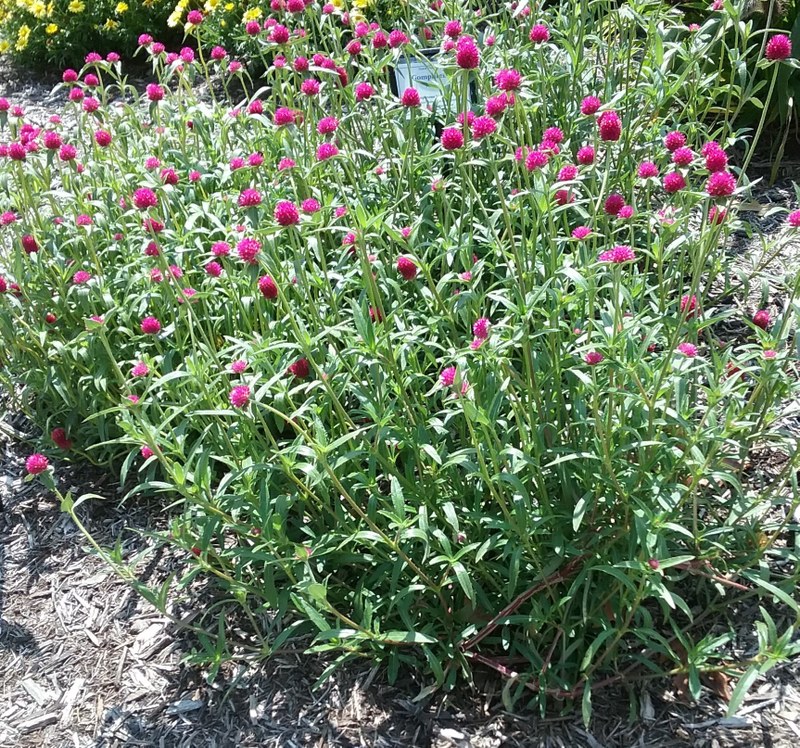
Sanvitalia procumbens 'Sunvy Super Gold' Creeping Zinnia (96%; 8-12 in. X 12-24 in.)
Not really a Zinnia, the Sanvitalia genus of the Asteraceae family is commonly referred to as 'Creeping Zinnia'. Native to Mexico this mat-forming flowering plant is easy to grow as an annual in northeast gardens. 'Sunvy Super Gold' is aptly named for the profusion of sun-bright little yellow flowers with a yellowish-green center. The low mounding shape delivers a delightful presentation of yellow flowers surrounded by medium green foliage on the procumbent stems throughout the season with no deadheading. Slightly undersized in our garden, the 7-inch high by 22-inch-wide plant held 220 flowers. Slow growth, less-than-ideal uniformity across the three plants, and some late-season hollowing in the center cost this cultivar a perfect score. All those flowers with no deadheading certainly made up for some slight late-season imperfection.

Lantana camara Luscious® Citrus Blend™ Lantana (98%; 18-30 in. X 18-24 in.)
Like most Lantana camara in the Trial Garden over the years, Luscious® Citrus Blend™ provided a strikingly spectacular display covering a large area. So why not a perfect score? Of the three plants, one started out a bit smaller than the others and it took a few weeks for it to catch up. Proven Winners describes the flowers as "brilliant Tabasco red, flaming orange, and fire ball yellow." Luscious® Citrus Blend™ filled the end of the Trail Garden with its brilliant flowers on sturdy upright stems on plants that maintained a rounded form. They caught your attention when approaching the garden. There were 212 dazzling flowers on a plant that measured 18 inches high and 36 inches wide at the beginning of August. Still delivering a colorful display in late October, the plants had increased their size by half.

Angelonia angustifolia AngelDance™ Fuchsia Bicolor Angelonia (99%; 14-18 in. X 12-24 in.; tt)
Be on the lookout for this cultivar in garden centers. It was completely captivating in the Trial Garden from shortly after it was planted. A few points missed at the first evaluation in early June kept AngelDance™ from a perfect score, but from there forward earned 5's in all categories. And none of the varmints that frequented the garden showed any interest in this beauty. This Angelonia flaunts huge long-lived flowers on tall stems with glossy dark green foliage below the blooms reaching to ground level. The summer heat, humidity, and drought did not deter AngelDance™ from standing up straight, sometimes swaying lightly in the wind, and producing bloom after bloom tightly clustered on tall stems. There were 50 blooms on our largest plants at 27 inches high and 24 inches tall. No penalty for growing bigger and better than expected.
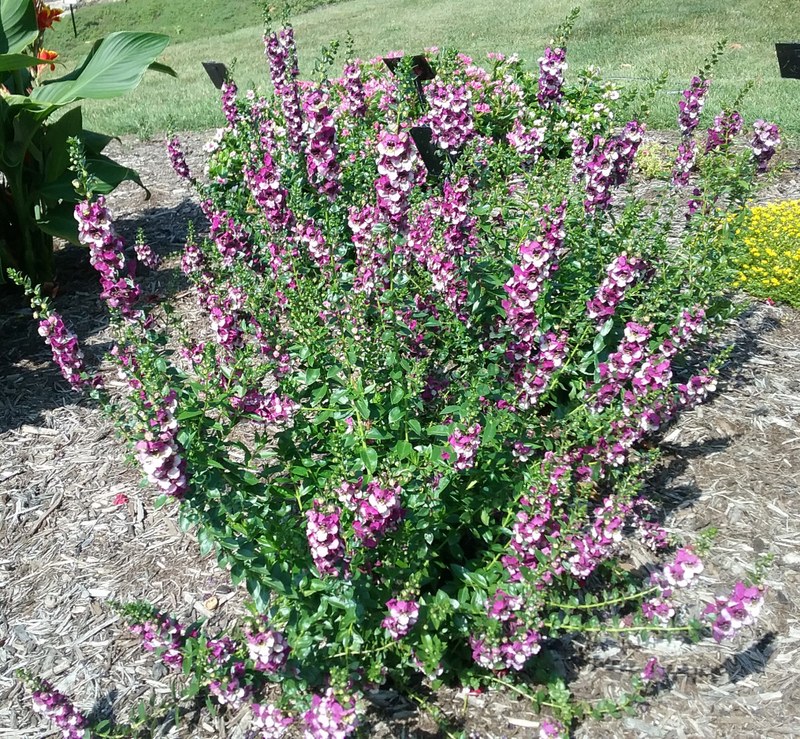
Mecardonia hybrid GoldDust® Axil Flower (99%; 2-5 in. X 12-16 in.; tt)
Just one point shy of perfect 5's for the whole season, GoldDust® was a true delight in the garden. (All those 5's really translated to 99.44%.) This heat-tolerant spreading annual is tightly covered in delicate vibrant yellow flowers, which never needed deadheading, perched above small green leaves. GoldDust® has smaller flowers than earlier introductions of Mecardonia hybrids but produces them in much larger numbers from May until frost. Imagine over 800 tiny yellow flowers on a plant 6 inches high and 26 inches wide. A low-profile plant, it is excellent for a border and could quickly form a ground cover when planted at appropriate intervals.
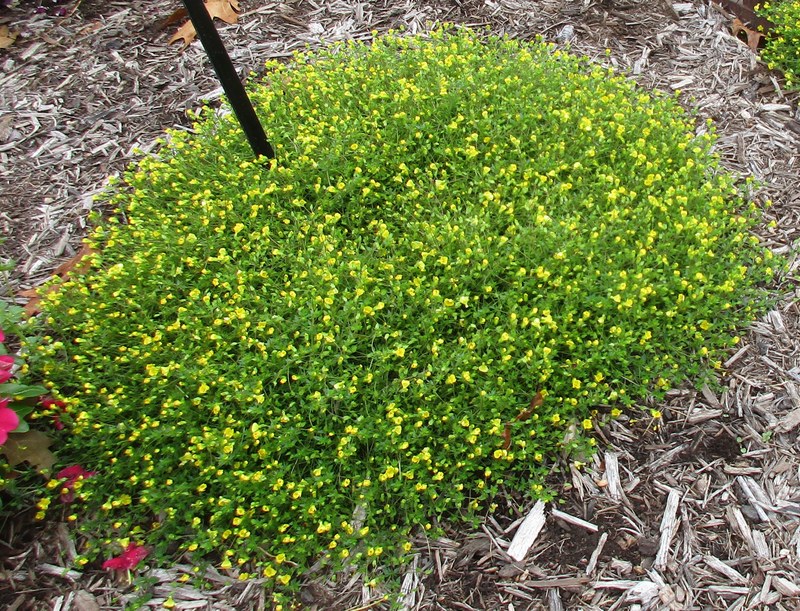
2023 Trial and Idea Garden Consolidated View of Ratings
The chart below summarizes the performance for all 21 cultivars that survived through the end of August listed in order based on the end of August score. Those in bold are the cultivars that thrived through the end of September and their score through September is included. In most cases, the plants that continued to be evaluated through the end of September overall had a slightly higher score when the additional month was included. Whereas those cultivars that were not evaluated past the end of August would certainly have had a much lower score. It is an interesting comparison, but the true value is in knowing that the 'September' group withstands the harsher conditions of late summer.
| True Trial | Botanical Name | Cultivar | End August | End September |
|---|---|---|---|---|
| tt | Calibrachoa hybrida | Bumble Bee™ Orange Calibrachoa | 61 | |
| tt | Sedum | 'Little Shimmer' Sedum | 80 | |
| tt | Catharanthus hybrid | SOIREE® DOUBLE Pink Vinca | 89 | 91 |
| Catharanthus roseus | Tattoo™ Black Cherry Vinca | 90 | 90 | |
| Lantana montevidensis | Luscious® Grape Lantana | 90 | 92 | |
| Argyranthemum intergeneric hybrid | Grandaisy® Red Improved | 91 | ||
| Dianthus chinensis | Coronet™ White Purple Eye Dianthus | 91 | ||
| Salvia x guaranitica | Bodacious® Hummingbird Falls Salvia | 92 | 84 | |
| tt | Catharanthus hybrid | SOIREE® Flamenco Senorita Pink Vinca | 93 | 94 |
| Petunia hybrid | Supertunia® Latte™ Petunia | 93 | ||
| Canna X generalis | Cannova® Red Golden Flame Canna Lily | 94 | 95 | |
| Celosia plumosa | 'Flamma Orange' Celosia | 94 | 93 | |
| Gazania rigens | Big Kiss™ Yellow Flame Gazania | 94 | ||
| tt | Gomphrena haageana | 'Piñata' Gomphrenia | 94 | 96 |
| Sanvitalia procumbens | 'Sunvy Super Gold' Creeping Zinnia | 96 | 96 | |
| Senna didymobotrya | Popcorn Cassia | 96 | 94 | |
| Pennisetum glaucum | 'Jade Princess' Ornamental Millet | 97 | ||
| tt | Angelonia angustifolia | AngelDance™ Fuchsia Bicolor Angelonia | 98 | 99 |
| Argyranthemum frutescens | Golden Butterfly® Marguerite Daisy | 98 | ||
| Lantana camara | Luscious® Citrus Blend™ Lantana | 98 | 98 | |
| tt | Mecardonia hybrid | GoldDust® Axil Flower | 99 | 99 |
Credits
Content courtesy of the Penn State Master Gardeners of Cumberland County Trial and Idea Garden Committee members
Photo Credit: Penn State Extension Master Gardener Janey Gunn
Penn State College of Agricultural Sciences research and extension programs are funded in part by Pennsylvania counties, the Commonwealth of Pennsylvania, and the U.S. Department of Agriculture.
Where trade names appear, no discrimination is intended, and no endorsement by Penn State Extension is implied.

